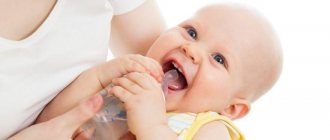29.01.2020 14269 0
- When to introduce the first complementary foods
- How to tell if your baby is ready for solid food
- Diet for young children
- Common mistakes in complementary feeding
- Prohibited products
- What to do if your child cannot eat solids
- Gameplay for eating
When a small child appears in a family, parents are faced with a difficult task: not only to raise and educate, but also to instill in the child all the necessary skills. For example, young parents are often concerned about how to teach their child to chew. We have collected advice for you from famous Russian and foreign pediatricians that will help you find the optimal solution.
What are the difficulties?
For adults, the process of chewing food seems completely natural. But the child only has a sucking reflex, and even liquid puree becomes unusual and unfamiliar food for him. In addition, the same period is characterized by other reflex reactions, due to which solid pieces of food that enter the mouth are rejected. They weaken by 4 months, but there is no need to wean the baby from the breast at this age: mother’s milk “adjusts” to the baby’s needs, its composition changes over time.
Possible problems: baby is choking, afraid to swallow, food causes vomiting
A child who is accustomed to receiving food only in liquid form does not always immediately perceive a denser consistency. In many cases, children begin to spit out food, turn away from the offered spoon with a new dish, or become capricious. When trying to feed a baby, the following situations occur:
- the child categorically refuses to eat food in pieces - the reasons may be laziness (why chew if you can get tasty food another way) or too abrupt a transition (the baby does not understand what to do with a piece that gets into the mouth);
- When eating, the baby often chokes - it is unusual for him to swallow food of a different consistency, but over time he learns to control his tongue and use chewing movements to push pieces into the oral cavity. It is necessary to give new foods little by little after the main feeding - a well-fed child will not try to quickly satisfy his hunger, which means he will be able to feel the new consistency;
- when trying to swallow a piece, an attack of vomiting occurs - this may occur due to incorrect feeding technique (the mother inserts the spoon too deeply). The volume of a baby spoon should not be more than 3 ml; it should touch the tip or middle of the tongue. If vomiting occurs frequently, you should consult a neurologist and gastroenterologist to rule out health problems;
- the child is afraid to chew and swallow - there is always a reason for such fear (previously, while eating, he choked and got scared; his mother gave him bitter medicine from this spoon). In such a situation, you need to consult a pediatrician.
You should not give your child medicine from the container that is used during feeding - the baby may have unpleasant associations, because children remember details well.
A special massage helps overcome the gag reflex during feeding. It can be done by speech therapists using a gauze pad (the child tries to push it out of the mouth with the tongue) or a wooden spatula (they need to gradually touch the tip of the tongue, moving towards the root). This way the baby gets used to the new sensations and no longer feels the urge to vomit when feeding from a spoon.
A child over 10 months old should not constantly choke while eating. This may signal health problems.
Pieces of food should be introduced gradually, starting with one spoon per day and over time replacing liquid food with solid food
How to tell if your baby is ready for solid food
As a rule, the baby himself makes it clear that he is interested in updating his diet. This can be seen from his behavior:
- Stops sucking food from a spoon, removing it with his lips
- Tries to chew
- Shows interest in “adult” food
- Puts hard objects into mouth
- Opens mouth wide when feeding
Usually this happens no earlier than 6-8 months - this is when you can start giving your child cereals and other foods with small dense particles.
Common mistakes
Young parents may involuntarily make mistakes. This is normal and should not cause panic: the first child is always difficult. If your baby refuses solid food, there are several reasons.
Particle size too large
. A child’s protective reflex is triggered, causing him to often spit out food. And if the piece is very large, the baby may start vomiting.
Complementary foods were introduced very late
. Some “specialists” and “experienced relatives” convince young mothers that they need to feed their baby breast milk for up to a year, without giving him other food. The baby gets used to this diet, and his chewing reflex does not develop. There is no need to be afraid, it is difficult, but it can be fixed.
The child does not like the taste
. Yes, he is already an independent person who has formed his own preferences. So the baby can easily eat broccoli and refuse the baked pear. Or vice versa. You should not force your child to eat something he doesn’t like or force him to finish the entire portion.
Negative associations
. Some psychologists believe that refusal to eat from a spoon may be caused by the fact that the child associates food with medicine (manifests itself in cases where the baby was given tasteless medicines).
Too many new products
. Don't try to include a lot of different foods in your diet. As Ellyn Satter writes in Feeding and Nourishing Your Baby with Love and Common Sense, it's best to add "scary and unfamiliar" foods to what your baby already loves, and in very small portions.
The child is fed like an adult
. Larisa Surkova writes in the book “How great it is with a child from 1 to 3 years old: a generator of useful tips”, you should not deny your baby tactile sensations. If he wants to crush food, sniff it, smear it on the table, let him do it. In the end, the table can be covered with oilcloth (and the floor, by the way, too).
Stages of reflex formation
Work on getting your baby used to solid food should be done gradually. It is customary to distinguish several stages.
- From 6 to 12 months – introduction of purees and cereals into the baby’s diet.
- From one to two years - active work on the formation of the chewing reflex; pieces of solid food should be included in the baby's diet.
- After 2 years, the child should already be able to chew foods well, including meat and fruits, this will indicate that he has developed chewing muscles and a formed reflex.
Of course, each baby is individual, but if by 10 months the child cannot even eat pureed food, you should immediately visit a specialist.
What to do if your child cannot eat solids
In some cases, even a one-year-old baby cannot chew food and constantly choke on small pieces. This means that the chewing reflex has not fully formed, and parents will have to act very delicately:
- Prepare thick cream soups and purees for your child, but leave a few tiny boiled pieces of vegetables when blending
- Later, the vegetables can be chopped with a fork; the pieces will become larger, but not hard enough for a child to choke on.
- The best effect will be achieved by products whose taste the child likes. These can be baked apples and pears, bananas, children's cookies
- Food needs to be made not only tasty, but also beautiful so that it attracts the baby
If, during the learning process, the child continues to choke and is unable to swallow solid food, this is a reason to consult a doctor who will find the cause of the problem.
When does a child begin to chew independently?
The chewing reflex is not innate: it is acquired during the process of growing up. This does not happen right away: not a single baby will start eating apples or cookies, having previously been fed only milk or formula. The “learning” process starts with the introduction of complementary foods. Despite the fact that new foods are given to the baby in the form of homogeneous purees, swallowing them is more difficult than liquid food - for this you need to use the tongue, work with the jaws and lips.
The chewing reflex begins to develop with the introduction of complementary foods
The chewing reflex is of great importance for the developing child’s body:
- affects the formation of the bite and oval of the face (this is due to the load on the jaw muscles involved in the process of chewing solid food);
- promotes digestion (stimulates the secretion of saliva, which, in turn, participates in the formation of enzymes and gastric juice);
- promotes speech development (the tongue becomes in the right position for the correct pronunciation of sounds).
Often, speech therapists insist on simultaneous treatment of the child by an orthodontist and a gastroenterologist, who help improve the digestion process and correct the shape of the jaw. If parents miss time, the baby may require surgical intervention, as well as classes with a speech pathologist to improve speech.
Game process
The child needs to be interested. A game story for eating is the absolute norm. During the process, you can tell your baby an interesting story in which he will be involved. The well-known “airplane” flying to the “hangar” is a real way to feed a child without nerves and hysterics. However, it is important to understand that if the baby begins to turn away, it means that he has already eaten. There is no need to feed him with the rest of the puree, even if it is only a spoon. Teaching a baby to eat “adult” solid food is a really difficult task that requires attention and patience from parents. Remember that you are helping your child develop one of the most important skills! On this path you need to become an ally to the baby. Force feeding will cause rejection. It is simply impossible to teach by feeding tasteless purees or forcing the child to finish eating porridge when the child is already full.
(2 ratings; article rating 5.0)
Share Share Share
How to teach a one-year-old child to chew
Today, more than half of children do not know how to chew by the age of 2.
You need to develop this skill from six months:
- Buy beautiful teethers (several types).
The child must not only relieve tension from the gums, but also learn to chew. The main thing is to remember to keep them clean and wash them regularly.
- Solid food.
As an introduction to food, instead of a teether, you can give a small bagel, a piece of carrot, or an apple. In the process of chewing with the gums, the baby will receive small pieces of treats. So the baby will understand that you can get a new taste on your own.
At the same time, parents should not leave their children unattended. The bagels are quite fragile, they can crumble, small pieces can block the respiratory system.
- Buy a nibbler.
A special device with a plastic (silicone) mesh, inside of which you can place pieces of fruits and vegetables. The nibbler will allow the child to get acquainted with new tastes and at the same time retains the pieces, so it is safe for the baby.
- Gradually introduce new foods.
You should not suddenly start feeding your child soup, like adults. Part of the usual food should be replaced with chunks, for example, leaving a few small pieces of potatoes in the mashed potatoes or decorating the porridge with fresh fruit.
- Reduce grind.
There is no need to give your baby large pieces right away; you can chop the food using a grater, a knife, or simply mash it with a fork. This does not apply to meat products: a child may not be able to chew the fibers and may choke. It is better to offer him a soufflé or steamed cutlets and meatballs.
Typically, these measures are enough for children to fully master chewing skills by the age of one and a half years.
You can learn more about how to teach your baby to chew solid food in different ways by watching the video.











